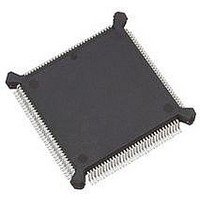MC68306EH16B Freescale Semiconductor, MC68306EH16B Datasheet - Page 80

MC68306EH16B
Manufacturer Part Number
MC68306EH16B
Description
IC MPU INTEGRATED 16MHZ 132-PQFP
Manufacturer
Freescale Semiconductor
Specifications of MC68306EH16B
Processor Type
M683xx 32-Bit
Speed
16MHz
Voltage
5V
Mounting Type
Surface Mount
Package / Case
132-MQFP, 132-PQFP
Controller Family/series
68K
Core Size
32 Bit
Cpu Speed
16.7MHz
No. Of Timers
1
Embedded Interface Type
UART
Digital Ic Case Style
PQFP
Supply Voltage Range
4.75V To 5.25V
Rohs Compliant
Yes
Lead Free Status / RoHS Status
Lead free / RoHS Compliant
Features
-
Available stocks
Company
Part Number
Manufacturer
Quantity
Price
Company:
Part Number:
MC68306EH16B
Manufacturer:
DATEL
Quantity:
87
Company:
Part Number:
MC68306EH16B
Manufacturer:
Freescale Semiconductor
Quantity:
10 000
Company:
Part Number:
MC68306EH16BR2
Manufacturer:
Freescale Semiconductor
Quantity:
10 000
Freescale Semiconductor, Inc.
4.5 EXCEPTION PROCESSING
This section describes the processing for each type of exception, exception priorities, the
return from an exception, and bus fault recovery. This section also describes the formats
of the exception stack frames.
Exception processing is the activity performed by the processor in preparing to execute a
special routine for any condition that causes an exception. In particular, exception
processing does not include the execution of the routine itself. Exception processing is the
transition from the normal processing of a program to the processing required for any
special internal or external condition that preempts normal processing. External conditions
that cause exceptions are interrupts from external devices, bus errors, and resets. Internal
conditions that cause exceptions are instructions, address errors, and tracing. For
example, the TRAP, TRAPV, CHK, RTE, and DIV instructions can generate exceptions as
part of their normal execution. In addition, illegal instructions and privilege violations cause
exceptions. Exception processing uses an exception vector table and an exception stack
frame.
Exception processing occurs in four functional steps. However, all individual bus cycles
associated with exception processing (vector acquisition, stacking, etc.) are not
guaranteed to occur in the order in which they are described in this section. Figure 4-3
illustrates a general flowchart for the steps taken by the processor during exception
processing.
During the first step, the processor makes an internal copy of the status register (SR).
Then the processor changes to the supervisor mode by setting the S-bit and inhibits
tracing of the exception handler by clearing the trace enable (T) bit in the SR. For the
reset and interrupt exceptions, the processor also updates the interrupt priority mask in
the SR.
During the second step, the processor determines the vector number for the exception.
For interrupts, the processor performs an interrupt acknowledge bus cycle to obtain the
vector number. For all other exceptions, internal logic provides the vector number. This
vector number is used in the last step to calculate the address of the exception vector.
Throughout this section, vector numbers are given in decimal notation.
4-12
MC68306 USER'S MANUAL
MOTOROLA
For More Information On This Product,
Go to: www.freescale.com











